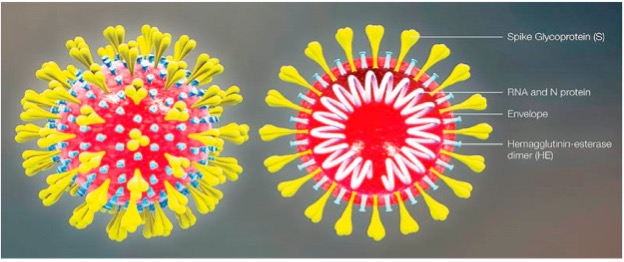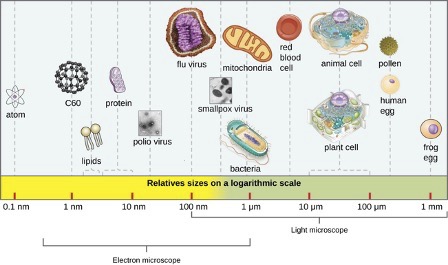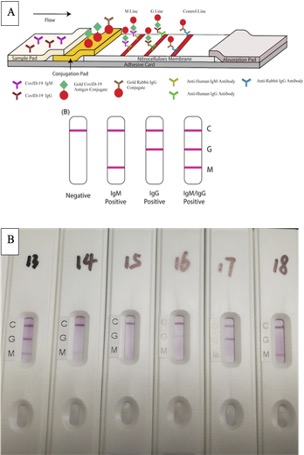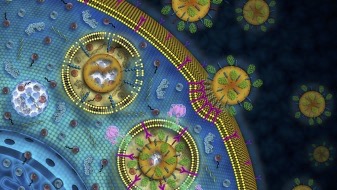Nanotechnology: An Interdisciplinary Field at the Forefront of Combatting the COVID-19 Pandemic
Effat Zeidan Hatoum, PhD
Director of General Education
California Baptist University, Online & Professional Studies Division
As the world transitions from a devastating COVID-19 pandemic year to another that holds promising glimpses of hope, the field of nanotechnology has captured the spotlight with its involvement in facilitating the availability of current vaccines and seeking potential future vaccines. Due to its unique rate of transmissibility and infectivity even before the onset of symptoms, the threatening virus has been spreading at a fast rate, causing a lag in therapeutic developments. This has caused a worldwide public crisis, leaving scientists and researchers pondering information on its transmissibility and progression of the virus in infected patients (Singhal, 2020). Many clarifications have been revealed regarding virus characteristics; however, there is much more still pending. The disease is accountable for the acute respiratory illnesses caused along other multi-organ complications in infected patients. Therefore, immunization has become the fastest route to controlling this new social disaster by combatting the COVID-19 virus and its spread. Nanoparticles have been explored as the main delivery vehicle of vaccine compounds that can immunize the human body against the SARS-CoV-2 virus (Fig. 1). Furthermore, the intervention of nanotechnology in the immunization trials against COVID-19 has allowed for the brief timeline in the development of current FDA “Emergency Use Authorized” vaccines (Rangayasami, et al., 2021).

Nanotechnology: Background and Applications
To give a brief background on nanotechnology, the research in this area studies and fabricates particles at the nanoscale that are the size of a billionth of a meter, such as human DNA, viruses, and proteins (Fig. 2). The field has grown over the last two decades by introducing cutting-edge advancements to various applications ranging from diagnostics, therapeutics, novel healthcare treatments, regenerative medicine, material, food, environmental science and many more. Nanotechnology is quite different from science at the macroscale or the science that we have studied for years. This field examines tiny sized-particles through a different lens, one that is interdisciplinary in nature and that collectively brings together different sciences and technologies to understand the unique behavior at the nanoscale. Scientists have employed the theory of quantum mechanics in understanding the behavior of nanoparticles as well as their interactions with biological compounds (Nieto-Chaupis, 2020). This field, which transcends classical mechanics at the atomic level, has enabled researchers to develop cutting-edge nanotechnologies currently employed in a multi-disciplinary collection of fields. For example, in nanomedicine, quantum mechanics enables the statistical analysis of the rate of drug release by the nanoparticles to their target cells in the body.

Nanoscale research on COVID-19
“Remember, viruses are the most beautiful, smart and capable nanoparticles!” Kostas Kostarelos would advise many of his students during his teaching of nanomedicine. As he explains, viruses are unique in their nanoscale features; they are smart in their ability to transfer their genetic material into the host cell and hijack its protein synthesis machinery (Kostarelos, 2020). Many viruses, equipped with unique structural nano-features, have caused serious illnesses in humans and have been originally transmitted from animals and transferred between humans in a highly contagious manner (Fig. 3). For a long time, viruses have been used for research and medical purposes in the transfer of molecules to human cells as well as genetic material. This is where nanotechnology has a primary role in generating important knowledge on the structural features of the SARS-CoV-2 virus that can assist in the understanding of the progression of the disease in patients.

Nanoparticles: Rapid and Reliable Detection of COVID-19
A second key factor in preventing the outbreak and cutting short the infections with the COVID-19 virus is the development of rapid and reliable testing tools. Nanoparticles have been researched for their potential usage in point-of-care immunodiagnostic testing for the COVID-19 virus. These special devices have shown promising results in their capability to detect the virus early on in infectious as well as non-infectious diseases (Mahato, et al., 2019). The most novel assay has been developed by Li et al. in which gold nanoparticles are utilized as probes in the construction of a sensitive surface on a test strip that analyzes the blood sample from infected or non-infected individuals. This test will yield results in less than 15 mins on whether an individual is infected with the SARS-CoV-2 virus or not. This constitutes another valuable contribution from nanoparticles to the efforts of combatting the COVID-19 pandemic. With this test, large scale screening of asymptomatic carriers is made possible; which is an added benefit that overcomes false positive/negative results obtained by current testing methods (Li, et al., 2020). The assay is provided for reference in Fig. 4A and Fig. 4B. Fig 4A demonstrates the structural features of the immunoassay synthesized by the help of gold nanoparticles and Fig 4B provides some examples from patients’ blood analysis.

Nanotechnology: Current COVID-19 Vaccines and Therapeutics
At this point in the prevention course of the pandemic, two vaccines against the COVID-19 virus have been approved by the FDA for “Emergency Use Authorization.” These have been administered widely across the world; both rely on the messenger RNA (mRNA) as the main immunization molecule. What’s remarkable about these two vaccines was their speedy development that has left a great number of people wondering how this was possible, especially when compared to previous courses of vaccine trials leading to the final stages of approval. Well, here again nanotechnology is central to these efforts by allowing this quick success in immunization trials. Both vaccines employ nanoparticles called “lipid nanoparticles” that envelop the mRNA coding for the SARS-CoV-2 spike proteins; which are expressed on the surface of the virus allowing entry to the human cell. The lipid nanoparticles are able to cross the human cell’s barrier and other biological gatekeepers, thereby delivering messenger RNA into the cell intact and to the targeted location, where it will be transcribed into specific proteins.
At this point in the prevention course of the pandemic, two vaccines against the COVID-19 virus have been approved by the FDA for “Emergency Use Authorization.” These have been administered widely across the world; both rely on the messenger RNA (mRNA) as the main immunization molecule. What’s remarkable about these two vaccines was their speedy development that has left a great number of people wondering how this was possible, especially when compared to previous courses of vaccine trials leading to the final stages of approval. Well, here again nanotechnology is central to these efforts by allowing this quick success in immunization trials. Both vaccines employ nanoparticles called “lipid nanoparticles” that envelop the mRNA coding for the SARS-CoV-2 spike proteins; which are expressed on the surface of the virus allowing entry to the human cell. The lipid nanoparticles are able to cross the human cell’s barrier and other biological gatekeepers, thereby delivering messenger RNA into the cell intact and to the targeted location, where it will be transcribed into specific proteins. Therefore, lipid nanoparticles are paving the way for non-invasive immunization against the SARS-CoV-2 virus (Al-Hatamleh, et al., 2021).

Final Thoughts
The pandemic with its urgency has highlighted to the world the significance of interdisciplinary research in the medical sciences. The collaboration across various fields in the sciences has left researchers at a better chance of putting an end to this harsh pandemic. And the most evident benefits of this interdisciplinary approach are the increasing contributions from the field of nanotechnology, which is interdisciplinary in nature. I want to leave you with some thoughts to reflect on. First, how can we implement an open and interdisciplinary approach in our response to the pandemic from our daily life activities? Second, how can we think outside the box in terms of the impact of COVID-19 on our lives? And finally; how should we respond to the challenges that will rise in the post-pandemic era as life goes back to normal?
Works Cited
Kostarelos, K. Nanoscale nights of COVID-19. Nat. Nanotechnol. 15, 343–344 (2020). https://doi.org/10.1038/s41565-020-0687-4
Li, Z, Yi, Y, Luo, X, et al. Development and clinical application of a rapid IgM‐IgG combined antibody test for SARS‐CoV‐2 infection diagnosis. J Med Virol. 2020; 92: 1518– 1524. https://doi.org/10.1002/jmv.25727
Mahato, K., Nagpal, S., Shah, M.A. et al. Gold nanoparticle surface engineering strategies and their applications in biomedicine and diagnostics. 3 Biotech 9, 57 (2019). https://doi.org/10.1007/s13205-019-1577-z
Nieto-Chaupis, H. (2020). Quantum Theory of Molecular Communications in Nanomedicine. 2020 Intermountain Engineering, Technology and Computing (IETC), Intermountain Engineering, Technology and Computing (IETC), 2020, 1–5. https://doi-org.libproxy.calbaptist.edu/10.1109/IETC47856.2020.9249162
Rangayasami, A., Kannan, K., Murugesan, S., Radhika, D., Sadasivuni, K. K., Reddy, K. R., & Raghu, A. V. (2021). Influence of nanotechnology to combat against COVID-19 for global health emergency: A review. Sensors International, 2. https://doi-org.libproxy.calbaptist.edu/10.1016/j.sintl.2020.100079
Singhal T. (2020). A Review of Coronavirus Disease-2019 (COVID-19). Indian journal of pediatrics, 87(4), 281–286. https://doi.org/10.1007/s12098-020-03263-6
